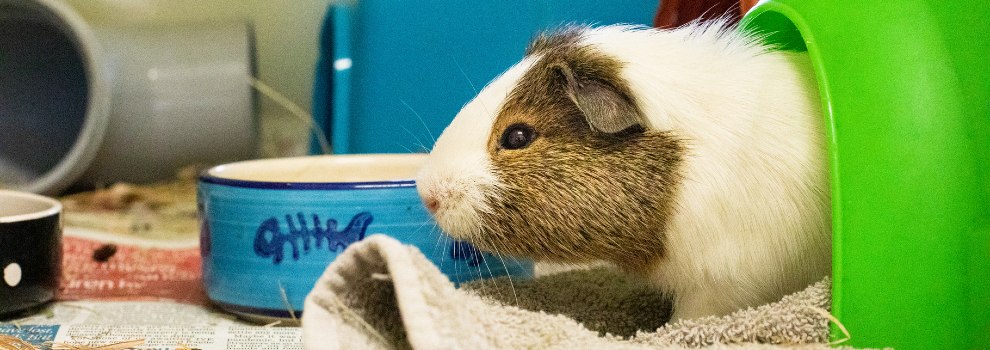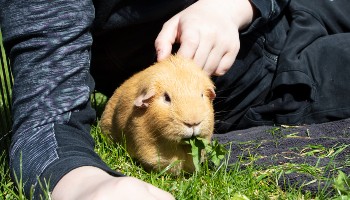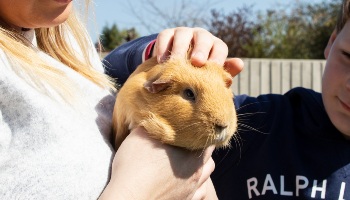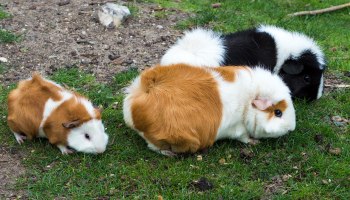Indoor and outdoor space to live
In terms of their living space, your guinea pig needs:
- A social group – guinea pigs are social animals and shouldn’t live by themselves.
- A secure space that's large enough for them to exercise and high enough to stand up fully on their back legs. Youngsters are especially playful and need lots of room – they’ll need a height of around 30cm to perform their ‘frisky hop’ play behaviour, also referred to as 'popcorning'.
- Indoor accommodation that's well-ventilated, dry and away from direct heat sources (such as radiators or sunny windows) and draughts. Room temperatures of 17–20°C are ideal. Some areas of centrally heated houses may get too hot, so be careful where you put their hutch. Guinea pigs don't cope well with big changes in temperature, so if you do decide to bring your guinea pigs inside for the winter, make sure you wait for the right temperature to reintroduce them to the outside again.
- A large exercise area and secure shelter where they can rest, feel safe and protected. Guinea pigs feel vulnerable in unprotected open spaces and like to stay in contact with solid surfaces. You can buy special ‘houses’ for inside the hutch, or provide cardboard boxes or tubes.
- A solid floor with a good depth of litter. Don't use grid floors as they let litter through and they can hurt guinea pigs' feet.
- Outdoor accommodation: if you're keeping your guinea pigs outside, their hutch should be sheltered from direct sun and direct wind. In temperatures below 15°C, you should move them indoors. They'll also need sufficient bedding throughout the whole enclosure to keep them warm.
Making your guinea pigs' house a home
Here's what you should do to make sure your guinea pigs' housing stays comfortable and interesting for them:
- Clean often - you should clean their accommodation regularly enough to keep it safe and hygienic, but not so often that they are frequently disturbed. On average guinea pig accommodation should be deep cleaned at least once a week, and spot cleaning should be carried out daily. The frequency with which the cage should be deep cleaned depends on the size of the cage and number of guinea pigs in it.
- Protect them from draughts and temperature extremes - guinea pigs are sensitive to temperature changes. Temperatures above 26°C can cause heatstroke; below 15°C can cause them to become chilled.
- Keep them in quiet, calm and safe areas away from dogs, cats, ferrets and other pets they may see as threats.
- Give them enough warm bedding - this should be safe to eat, such as dust-free hay. Don't use softwood products such as pine, as these can cause illness, and don't give them nesting materials that separate into thin strands, such as cotton wool or similar 'fluffy' bedding products. They pose a serious risk to their health and welfare, as they can become tangled in them and they aren't safe to eat. Coarse materials like straw should also be avoided as they can cause eye injuries.
- Litter material on the floor – the best type is dry, dust-free, absorbent wood shavings supplemented with hay to allow animals to tunnel and hide. Wood wool is also good for hiding in.
- Regular exercise - ideally, give your guinea pigs free access to an exercise area with pipes and shelters to encourage exercising. They're active animals and need opportunities to run, stand fully upright on their back legs and stretch out when lying down.
- Give them tunnels and untreated wooden toys to chew. Avoid plastic toys as they may harm them if chewed or swallowed. Guinea pigs are intelligent and enjoy gnawing, chewing and exploring.
- Something to gnaw – guinea pigs’ incisor teeth grow continually so they need untreated wooden toys, bits of fruit trees or willow sticks to chew in order to wear the teeth down.
-
An interesting diet and the ability to forage. Give your guinea pigs a varied diet, including meadow hay, forage mix, fruit and vegetables. Sliced cucumber is a particular favourite and cabbage and kale are good sources of vitamin C. Scatter forage mix within the substrate to encourage foraging, along with chew sticks and hard food pellets to gnaw on.
Handling your guinea pig
Handle guinea pigs gently but firmly. They should quickly become accustomed to it, although they may still squeal when handled.
Many of their natural predators are birds, so they’re easily alarmed when approached from above. Instead, approach from the front at a low level. Hold them with one hand supporting the hindquarters and the other around the shoulders (for young animals) or chest (for adults).
Potential welfare problems
Overgrown teeth or claws can develop if guinea pigs don’t have enough items to gnaw on, or if flooring is inadequate to wear the claws down. A vet can trim teeth and claws but it’s better to prevent these problems before they start.
Guinea pigs can suffer stress if they’re repeatedly frightened and can’t hide. Make sure they have refuge areas and peace and quiet – these should exceed the number of animals by one. Giving the extra food treats can help them associate humans with a positive experience and keep them calm too.
When you're away or on the move
If you go away, here's what you'll need to do to avoid stressing your guinea pigs:
- Get someone to look after them - you'll ideally need to find a responsible person to care for your guinea pigs in their familiar home when you're away. If you're boarding them elsewhere, keep grouped guinea pigs together and take familiar items such as toys. Guinea pigs prefer routine and can become stressed if they're around lots of noise and activity.
- Transport them comfortably - keep your guinea pigs safe and comfortable when you're transporting them. Help them feel at ease by putting familiar-smelling objects in the travel carrier and moving them with their companion(s).




